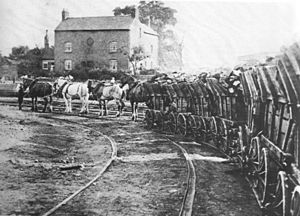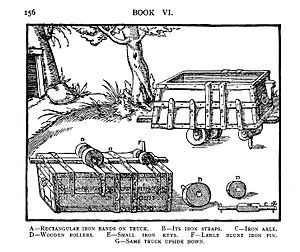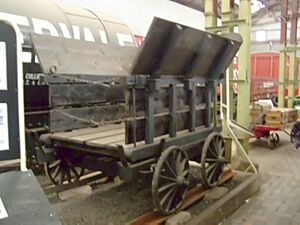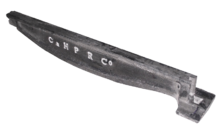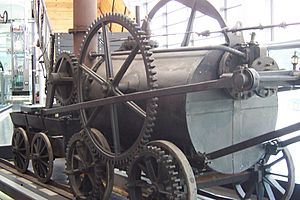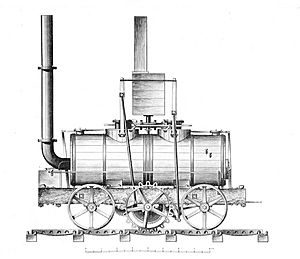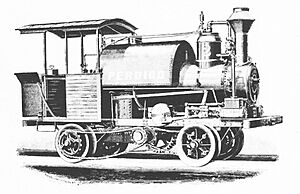Wagonway facts for kids
Wagonways (also spelled Waggonways) were early forms of railways. They used horses, special equipment, and tracks to pull wagons. These systems existed before steam-powered trains became common. Other names for them included horse-drawn railways, tramways, and dramways. The main benefit of wagonways was that horses could pull much heavier loads than they could on regular roads.
Contents
Early Trackways: Ancient Systems
The very first evidence of a trackway is the Diolkos in Greece, built around 600 BC. This paved trackway was about 6 to 8.5 kilometers (3.7 to 5.3 miles) long. It was used to move boats across the Isthmus of Corinth. Wheeled carts, pulled by people and animals, ran in grooves cut into limestone. This kept the wagons on the right path. The Diolkos was used for over 650 years! Later, similar paved trackways were built in Roman Egypt.
Wooden Tracks: The First Wagonways
In 1556, a German book called De re metallica showed how these systems worked. Miners used carts called "Hund" (meaning "dogs" because of the noise they made). These carts had wheels without flanges (the raised edge that keeps a train wheel on the track). Instead, a pin on the cart fit into a gap between two wooden planks, guiding the cart.
Around 1568, German miners in England also used this system. In 1604, Huntingdon Beaumont built the Wollaton Wagonway in England to move coal from mines to a nearby town. Other early wagonways were found in Shropshire from 1605.
The Middleton Railway in Leeds, England, started as a wagonway in 1758. It later became the world's first working railway (not counting funiculars). In 1764, the first railway in America was built in Lewiston, New York, also as a wagonway.
Wagonways greatly improved coal transport. One horse could pull 10 to 13 tons (about 22,000 to 28,000 pounds) of coal in one trip. This was about four times more than a horse could pull on a road! Wagonways were often built so that loaded wagons traveled downhill to a canal or boat dock. Then, empty wagons were pulled back uphill to the mine.
Stronger Tracks: Metal Rails Appear
At first, rails were made of wood. They were a few inches wide and laid on wooden logs called "sleepers." To make them last longer and reduce rubbing, people started covering the wooden rails with thin, flat iron plates. This led to iron wheels being used on wagons. However, these thin iron plates weren't strong enough. They would bend under heavy loads. So, people started making rails entirely out of iron.
In 1760, the Coalbrookdale Iron Works began adding iron bars to their wooden tramway. This made it easier to move wagons and saved money. By 1767, they started making rails from cast iron. These early iron rails were about 6 feet (1.8 meters) long and had special "ears" to attach them to the wooden sleepers.
Plateways and Edgeways
A later system used L-shaped iron rails or "plates." Each plate was about 3 feet (0.9 meters) long and 4 inches (100 mm) wide. They had an upright edge or "flange" on the inside, about 3 inches (76 mm) high, to keep the flat-wheeled wagons on the track. Later, another flange was added underneath for more strength. Wooden sleepers were still used, but around 1793, stone blocks started to be used instead. This type of rail was called a "plate-rail" or "tramway-plate." The workers who lay and fix railway tracks are still called "platelayers" today.
Another type of rail, called the "edge rail," was first used in 1789 by William Jessop. Unlike plateways, edge rails were smooth on top. Wagons using edge rails had wheels with flanges, just like modern train wheels. This system was used on the Lake Lock Rail Road in Yorkshire, which opened in 1798 and was the world's oldest public railway.
Both plate-rails and edge-rails were used until the early 1800s. Plate-rails were popular in many parts of England because they could handle wagons with different wheel spacings. However, wheels tended to get stuck against the flange of the plate rail, and mud would build up. Edge-rails became more popular in the North of England and Scotland, and soon their advantages were clear.
Rails continued to improve. They were made longer, which meant fewer joints (the weakest parts of the track). Wrought iron, which is stronger than cast iron, also started to be used more after 1820. George Stephenson used these improved rails on the Stockton & Darlington and Canterbury & Whitstable railways.
The Power of Steam
In 1804, Richard Trevithick used a steam locomotive on a railway for the first time. His engine had smooth wheels and ran on an L-shaped plateway. However, it was more expensive than using horses. His engine made three trips, but it kept breaking the rails, which were only designed for horse-drawn wagons. At the time, many people doubted that smooth wheels could get enough grip on smooth rails.
In 1811, Mr. Blenkinsop patented the use of cogged (toothed) wheels. In 1812, the Middleton Railway successfully used steam locomotives with two cylinders. George Stephenson built his first steam locomotive in 1813. He discovered that smooth wheels on smooth rails actually provided enough grip.
In 1821, a wagonway was planned to connect mines in West Durham with Darlington and the River Tees. George Stephenson convinced people that horse-drawn wagonways were old-fashioned. He argued that a steam-powered railway could carry 50 times more coal! In 1825, he built the locomotive Locomotion No. 1 for the Stockton and Darlington Railway in England. This became the world's first public steam railway in 1825, using both horses and steam power.
Even after steam engines became common, horses were still used. They were handy for moving wagons around in station yards because they didn't need time to "raise steam" (heat up the boiler).
Temporary Tracks: Pole Roads
Wooden rails were still used for temporary railways even into the 1900s. Some logging companies in the United States built "pole roads" using logs that couldn't be sold. These logs were basically free, making the tracks very cheap to build. Since loggers moved to new areas after clearing a forest, the tracks didn't need to be permanent. Some pole road systems were reportedly as long as 20 miles (32 kilometers).
Pole rails were usually logs about 8 to 12 inches (20 to 30 cm) wide. They were laid parallel directly on the ground without cross-ties. Wagons on pole roads often had wheels with a curved shape that hugged the top of the logs. Steam engines and special locomotives were used to pull trains of logs. For example, the Perdido locomotive was built in 1885 and could pull up to seven cars of logs.
The End of Wagonways
As steam power slowly replaced horse power throughout the 1800s, the term "wagonway" became less common. It was replaced by "railway." Today, very few horse or cable-hauled freight railways are still working. Notable examples include the cable-hauled St Michael's Mount Tramway and the Reisszug, which has been running since around 1500! A few passenger lines still operate, like the horse-hauled Douglas Bay Horse Tramway and the famous San Francisco cable cars.
Images for kids
See also
- Barlow rail
- Granite Railway
- Guide rail
- Hay Railway
- Holy Island Waggonway
- Horsecar
- Mine railway
- Rail profile


